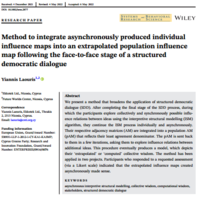Method to integrate asynchronously produced individual influence maps into an extrapolated population influence map following the face-to-face stage of a structured democratic dialogue: Difference between revisions
(Created webpage for Method to integrate asynchronously produced individual influence maps into an extrapolated population influence map following the face-to-face stage of a structured democratic dialogue) |
(edited the download) |
||
| Line 23: | Line 23: | ||
Laouris, Y. (2023). Method to integrate asynchronously produced individual influence maps into an extrapolated population influence map following the face‐to‐face stage of a structured democratic dialogue. Systems Research and Behavioral Science, 40(3), 437-450. | Laouris, Y. (2023). Method to integrate asynchronously produced individual influence maps into an extrapolated population influence map following the face‐to‐face stage of a structured democratic dialogue. Systems Research and Behavioral Science, 40(3), 437-450. | ||
[[Media: | [[Media:2022_Laouris_Asynchronous_ISM_PostPartialISM_Published.pdf|Download Paper]] | ||
[[Category:Journal Publication]] | [[Category:Journal Publication]] | ||
[[Category:Publications with SDDs]] | [[Category:Publications with SDDs]] | ||
Latest revision as of 03:17, 24 November 2023
|
Abstract
We present a method that broadens the application of structured democratic dialogue (SDD). After completing the final stage of the SDD process, during which the participants explore collectively and synchronously possible influence relations between ideas using the interpretive structural modelling (ISM) algorithm, they continue the ISM process individually and asynchronously. Their respective adjacency matrices (AM) are integrated into a population AM (pAM) that reflects their least agreement denominator. The pAM is sent back to them in a few iterations, asking them to explore influence relations between additional ideas. This procedure eventually produces a model, which depicts their ‘extrapolated’ or ‘computed’ collective wisdom. The method has been applied in two projects. Participants who responded to a requested assessment (via a Likert scale) indicated that the extrapolated influence maps created asynchronously made sense.
Citation
Laouris, Y. (2023). Method to integrate asynchronously produced individual influence maps into an extrapolated population influence map following the face‐to‐face stage of a structured democratic dialogue. Systems Research and Behavioral Science, 40(3), 437-450.
